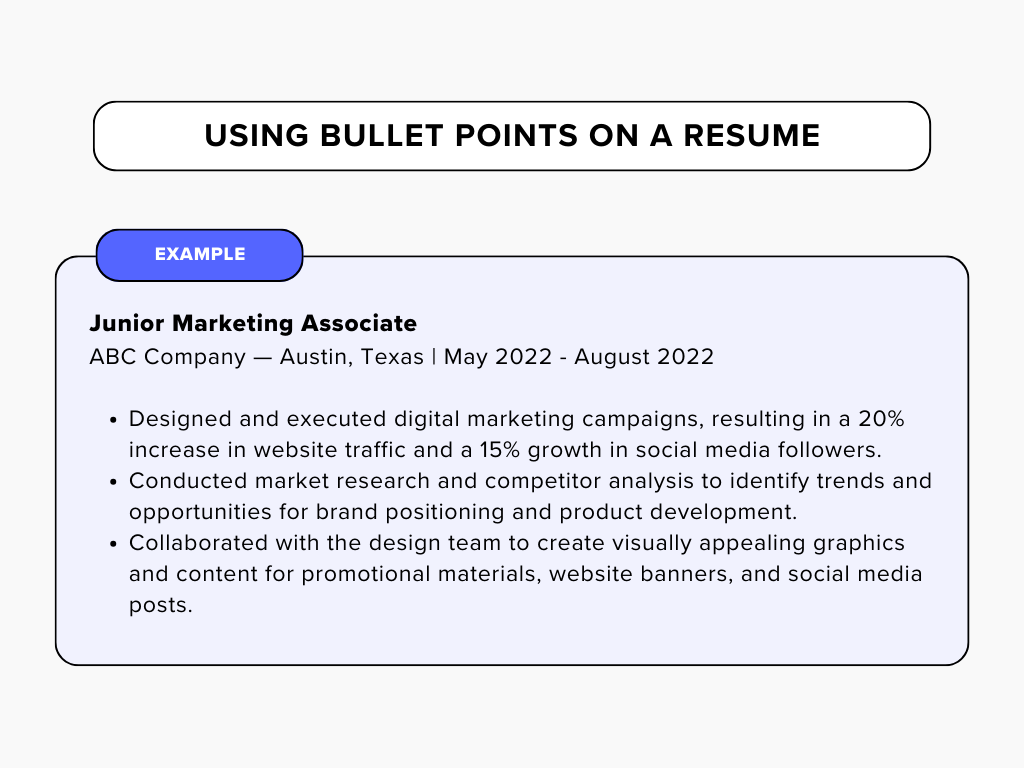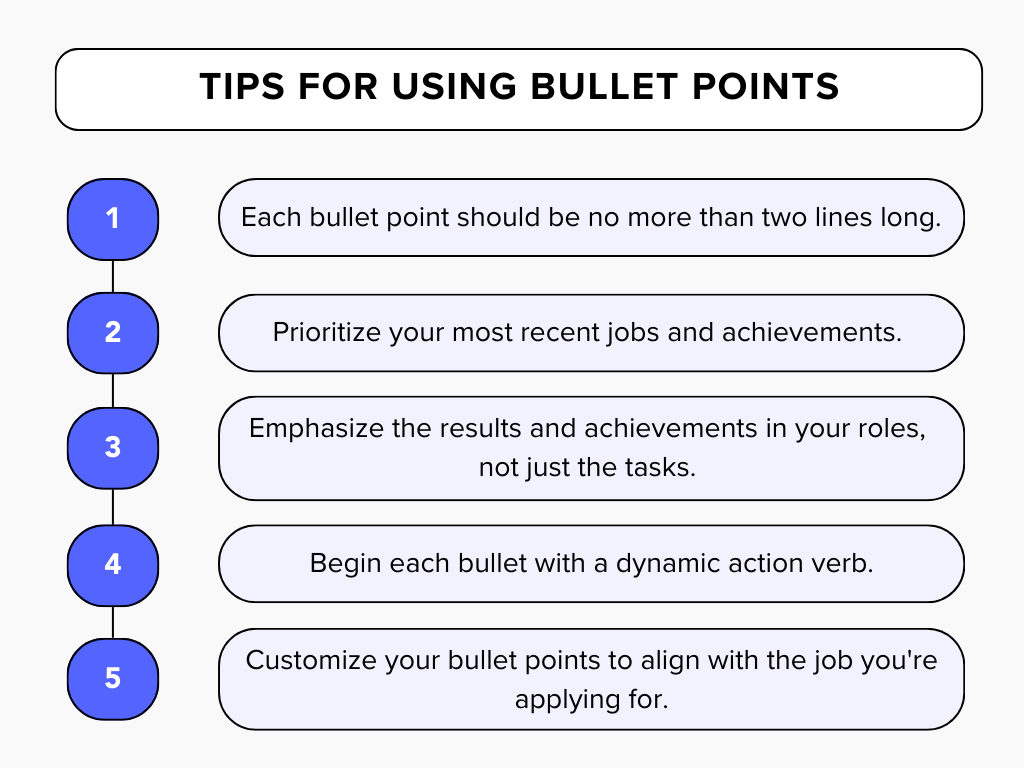Bullet points make your accomplishments and qualifications stand out. They’re a quick and easy way for hiring managers to see your expertise— which is important considering hiring teams only spend an average of six to seven seconds looking at a resume.
How many bullet points should I use per job on my resume?
There’s no one-size-fits-all answer, but here’s a rule of thumb: aim for 3-5 bullet points per job.
Why 3-5? It strikes a balance between providing enough information to impress potential employers and keeping things concise. Remember, hiring managers don’t have all day to read your resume. They want the highlights, not a novel.

Of course, there are exceptions. If you’re early in your career or have held many short-term positions, adjust accordingly. You might have fewer bullet points for each job, but make sure they pack a punch.
On the flipside, you may have a highly technical job where it’s common to expand upon experience in your resume. Or perhaps you have held a position at one company for a long period of time. In cases like these, you may want to include more bullet points to touch on important experiences.
RELATED: How Long Should a Resume Be?
Tips for using bullet points on your resume
Keep the following tips in mind to maximize the effectiveness of your bullet points.

1. Be clear and concise.
Bullet points should be short and to the, well, point. To do this:
- Each bullet should be no more than two lines long. This helps the reader quickly grasp the key points.
- Use clear, straightforward language that anyone can understand. Avoid industry jargon or acronyms that might not be familiar to all readers.
- Ensure that all bullet points are consistently formatted. This includes the same bullet style, font size, alignment, and verb tense.
Following these three rules of thumb will ensure that your resume is easy to read.
2. Prioritize information.
Don’t describe the job you had fifteen years ago in detail and leave your most recent job looking sparse. Prioritize your most recent jobs and achievements.
Additionally, you’ll want to be sure to place the most impressive and relevant achievements near the top of each section. This ensures that these points are seen first.
3. Focus on accomplishments, not just duties.
Emphasize the results and achievements in your roles, not just the tasks you performed.
Did you increase sales by 45%? Manage 13 high-profile accounts? Grow your website’s traffic by 25,000 users?
Whenever possible, use numbers, percentages, or other quantifiable metrics to demonstrate the impact of your work. Stats like these can wow recruiters and demonstrate your value and effectiveness.
4. Start with strong action verbs.
Begin each bullet point with a dynamic action verb (e.g., managed, developed, led) to convey your role and accomplishments clearly.
5. Tailor your resume to the job.
Customize your bullet points to align with the job you’re applying for. Highlight skills and experiences that are most relevant to the position.
It’s also smart to incorporate language and keywords from the job posting. This can help your resume pass through an Applicant Tracking System (ATS) and show that your experience aligns well with the job requirements.
Where can I use bullet points on my resume?
Bullet points aren’t just for jobs! They can be used several places in your resume:
- Job summaries: Your job descriptions are the perfect place to start. Summarize your role, responsibilities, and achievements in a few well-crafted bullet points. This makes it easy for recruiters to see what you bring to the table.
- Skills: Got a list of skills you want to showcase? Bullet points are your go-to here. Whether it’s hard skills or soft skills, use bullets to highlight what you excel at.
- Achievements: Your accomplishments deserve the spotlight. Use bullet points to call attention to your major wins in each job. Did you increase revenue by 20% or lead a team to meet tight deadlines? Bullet point it!
You have limited space on your resume. Bullet points are the best way to get the most important points across quickly.
The bottom line
The ideal number of bullet points for each job on a resume is not a straightforward answer, but rather a balance between conciseness and comprehensiveness. Generally, 3 to 5 bullet points per job position are recommended to succinctly convey your key responsibilities and achievements.
The goal is to highlight your most relevant experiences and accomplishments that align with the job you’re applying for. By focusing on impactful, quantifiable achievements and maintaining a clear, organized format, your resume will effectively communicate your professional story and catch the attention of potential employers.
Remember, quality trumps quantity. Focus on showcasing your value through precise, meaningful examples rather than overwhelming the reader with excessive details.
